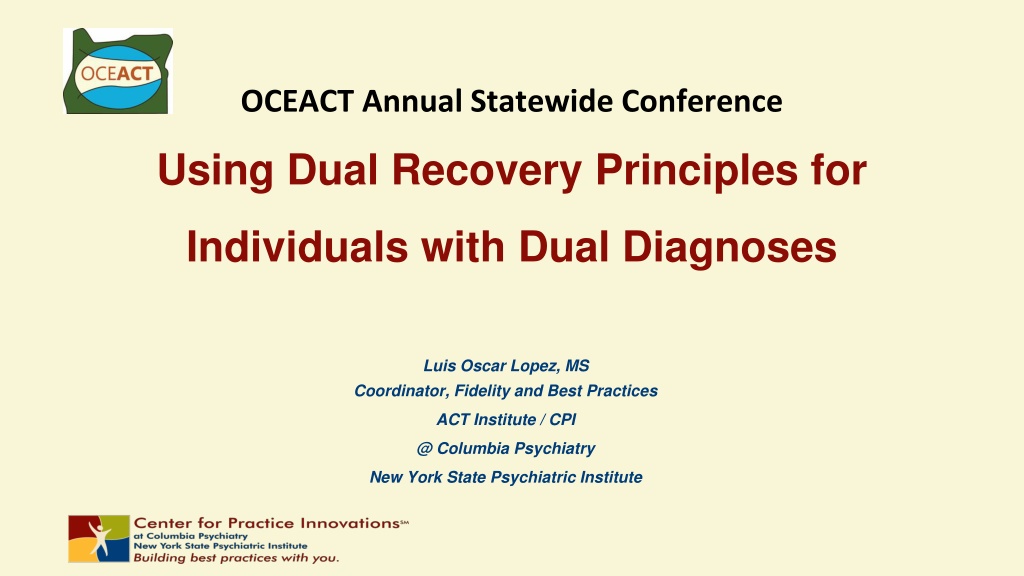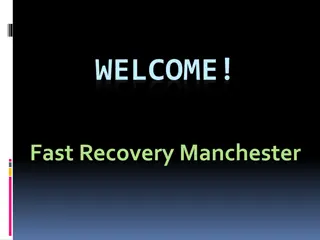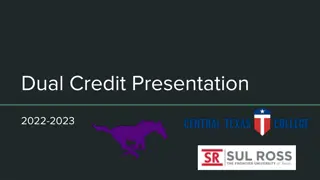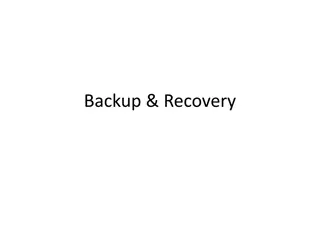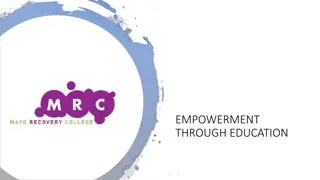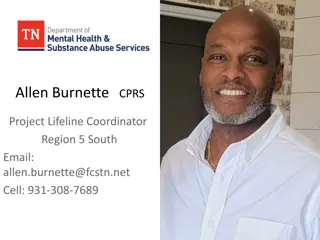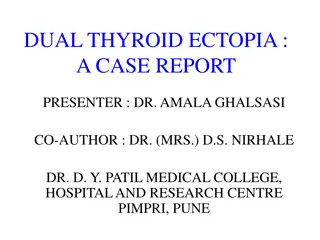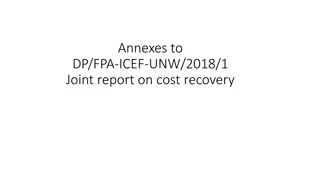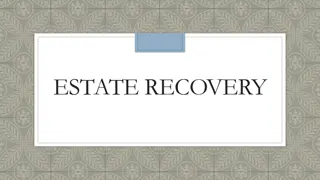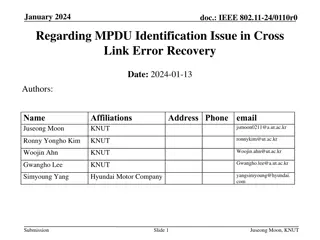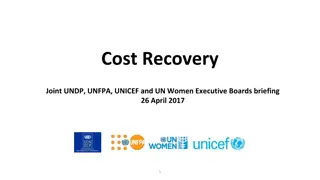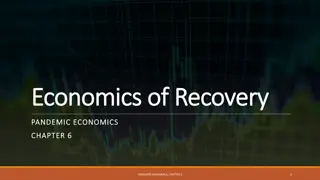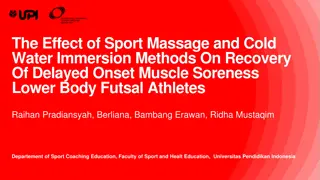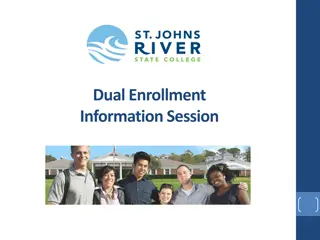Enhancing Recovery: Dual Diagnosis Principles" (47 characters)
"Explore the application of Dual Recovery Principles for individuals with co-occurring disorders. Gain insights from Luis Oscar Lopez on best practices and fidelity in treatment, emphasizing Integrated Dual Disorder Treatment (IDDT)." (194 characters)
Download Presentation

Please find below an Image/Link to download the presentation.
The content on the website is provided AS IS for your information and personal use only. It may not be sold, licensed, or shared on other websites without obtaining consent from the author. Download presentation by click this link. If you encounter any issues during the download, it is possible that the publisher has removed the file from their server.
E N D
Presentation Transcript
OCEACT Annual Statewide Conference Using Dual Recovery Principles for Individuals with Dual Diagnoses Luis Oscar Lopez, MS Coordinator, Fidelity and Best Practices ACT Institute / CPI @ Columbia Psychiatry New York State Psychiatric Institute
IDDT 2 Presenter Luis O. Lopez, MS - Center for Practice Innovations LOL 10/2/2024
OBJECTIVES 3 Reviewing the Research and the Statistics Brief History Harm Reduction Old Assumptions Confrontation and Blaming Why should we practice Integrated Dual Disorder Treatment? LOL 10/2/2024
OBJECTIVES 4 Recovery Stages of Change IDDT Motivational Interventions Discussion LOL 10/2/2024
REVIEWING THE STATISTICS 5 According to Gorski (1994), studies show that approximately 85% of individuals that experienced recurrent drug challenges on a regular basis, have a co- existing psychiatric, psychological or emotional diagnosis. LOL 10/2/2024
REVIEWING THE STATISTICS 6 Substance abuse is more common among people with severe mental illness than among the general population. About 50% of people with severe mental illness develop substance use disorders at some point during their lives. LOL 10/2/2024
REVIEWING THE STATISTICS 7 In intensive psychiatric treatment settings, 50% of the patients are affected by substance abuse or dependence. People suffering from Schizophrenia / Schizophreniform disorders have a higher rate of substance abuse incidents than the general population (47% vs 17%). LOL 10/2/2024
REVIEWING THE STATISTICS 8 People suffering from Bipolar disorders also have a higher rate of substance abuse incidents than the general population (56%) . Over 50% of homeless individuals suffer from COD. In many urban areas, these percentages are higher. LOL 10/2/2024
REVIEWING THE STATISTICS 9 Substance abuse among individuals with severe mental illnesses is associated with higher suicide rates an increase of psychiatric symptoms disruptive behaviors hostile and assaultive actions poor self-care LOL 10/2/2024
REVIEWING THE STATISTICS 10 Individuals with co-occurring disorders have higher rates of homelessness, poor social functioning, institutionalizations in both, hospitals and jails. LOL 10/2/2024
REVIEWING THE STATISTICS 11 Sources SAMHSA s Reports National Survey on Drug Abuse / Co-Occurring Diagnoses National Outcomes Measures NIDA LOL 10/2/2024
BRIEF HISTORY 12 Historically, individuals experiencing psychiatric / psychological challenges and struggling with substance abuse issues, are not diagnosed by clinicians as having co-occurring disorders. (NIDA, 1991) LOL 10/2/2024
BRIEF HISTORY 13 Historically, individuals experiencing co-existing challenges only receive one primary diagnosis - an Axis 1 mental health diagnosis or an Axis 1 substance abuse diagnosis. LOL 10/2/2024
BRIEF HISTORY 14 If a person receives an Axis 1 mental health diagnosis, the substance abuse challenge becomes secondary. If the Axis 1 diagnosis is substance abuse, the mental health diagnosis becomes secondary. LOL 10/2/2024
BRIEF HISTORY 15 Historically, individuals experiencing co-occurring disorders, received separate therapeutic services. These separate therapeutic services created confusion, misdirection, tension, and, ultimately, resistance. LOL 10/2/2024
BRIEF HISTORY 16 Mental Health Issues under a Substance Abuse Model Mental Health problems derived / originated from alcohol / drug use. Psychotropic Medication usage is suspiciously questioned. Most treatment modalities are confrontational. LOL 10/2/2024
BRIEF HISTORY 17 Substance Abuse Issues under a Mental Health Model Substance Abuse issues are avoided. When identified, substance abuse issues are referred to agency SA counselor or outside services. Substance Abuse support groups are extremely limited. LOL 10/2/2024
Old Assumptions 18 Stigma The most common perception by the general population (including behavioral health workers) of individuals with psychiatric disabilities is that besides having an illness these individuals are also non-complaint, treatment resistant, unmotivated, bad, hostile, and violent. LOL 10/2/2024
Confrontation and Blaming 19 Historically, individuals were blamed for their struggles with co-occurring diagnoses Blaming interferes with engagement. Blaming creates skepticism and ignores the possibility of change. Blaming creates guilt - increasing the feelings of hopelessness. LOL 10/2/2024
Why should we practice Integrated Dual Disorder Treatment? 20 Working with people suffering from co-occurring disorders (COD) is often very difficult. A person suffering with COD will not experience quick changes in their sobriety. LOL 10/2/2024
Why should we practice Integrated Dual Disorder Treatment? 21 Treatment modalities have incompatible philosophies and (frequently) are not integrated. Historically, counselors have confronted and blamed persons with COD for appearing unmotivated, insincere, and avoidant. LOL 10/2/2024
Why should we practice Integrated Dual Disorder Treatment? 22 In IDDT, the responsibility for the person getting better is shared by both counselor and person. Counselor and person develop a working alliance. Counselor and person meet on a regular basis. LOL 10/2/2024
Why should we practice Integrated Dual Disorder Treatment? 23 Both, mental health and substance abuse disorders are targeted concurrently. Both issues are viewed as primary not sequential. Counselors work side by side on the same treatment team. Philosophical differences are minimized. LOL 10/2/2024
Why should we practice Integrated Dual Disorder Treatment? 24 Counselors work on reducing negative interventions, such as blaming. Counselors work on reducing the negative consequences . LOL 10/2/2024
Recovery 25 Through out the recovery process, the case manager / clinician provides services to consumers that promote Hope Empathy Motivation Self-confidence Meaning Independence Compassion Transparency Spirituality Perspective LOL 10/2/2024
Stages of Change: Prochaska / DiClemente 26 LOL 10/2/2024
Stages of Change 27 Pre-contemplation Contemplation Preparation / Determination Action Maintenance Termination Recurrence LOL 10/2/2024
Stages of Change 28 Pre-contemplation = person is not engaged, there is no connection, person is not ready Contemplation = person is not completely engaged, ambivalent Preparation = person is engaged, person is exploring a plan of action Action = person is ready to execute, person executes Maintenance = person is involved Recurrence = person transitions into an earlier stage LOL 10/2/2024
Stages of Change 29 PRECONTEMPLATION CONTEMPLATION recurrence PREPARATION MAINTENANCE ACTION LOL 10/2/2024
MI Elements: A ROSE 30 The counselor does not prescribe to any specific / traditional technique (i.e., psychoanalysis, etc.) Allow person to choose their own path... and come out smelling like A ROSE Affirm the person = be positive about strengths Reflect = reflective / active listening Open ended questions = no short answers Summarize = draw person s own opinion Elicit Change Talk LOL 10/2/2024
MI Elements: A ROSE 31 A ROSE (Affirm, Reflect, Open, Summarize, Elicit) Affirm continuously comment positively on the person s strengths, efforts, intentions, and opinions Example I am very happy that you came to see me today. Thank you for sharing this information with me. LOL 10/2/2024
MI Elements: A ROSE 32 Exercise LOL 10/2/2024
MI Elements: A ROSE 33 A ROSE (Affirm, Reflect, Open, Summarize, Elicit) Reflective Listening seek to summarize what the person means repeat = restate what the person stated (simple reflection) rephrase = restate using a few different terms (simple reflection) paraphrase = restate by using different terms and adding a possible connection or meaning not originally implied (amplified reflection) reframing = carefully change point of view into a positive statement LOL 10/2/2024
MI Elements: A ROSE 34 Exercise LOL 10/2/2024
MI Elements: A ROSE 35 A ROSE (Affirm, Reflect, Open, Summarize, Elicit) Open Ended open ended questions encourage discussion open ended questions never start with a verb or action word Example Are you going to the doctor? Is she coming to see you? Do you want to live here? open ended questions should start with suggestions and a W question Example Please, explain to me what happen list night? Please, tell me again where would you like to work? LOL 10/2/2024
MI Elements: A ROSE 36 Exercise LOL 10/2/2024
MI Elements: A ROSE 37 A ROSE (Affirm, Reflect, Open, Summarize, Elicit) Summarize review with person his/her perspective about the conversation and potential/decision for change LOL 10/2/2024
MI Elements: A ROSE 38 Exercise LOL 10/2/2024
MI Key Elements in Action: A ROSE 39 Elicit Change Talk We need to give a D.A.R.N.!!!!!!!!! LOL 10/2/2024
MI Key Elements in Action: A ROSE 40 Elicit Change Talk Person s resistance typically is a behavior evoked by environmental conditions. Counselor invites person to argue for change Counselor explores and elicits commitment words Desire, Ability, Reasons, and Need LOL 10/2/2024
MI Key Elements in Action: Summary 41 People are responsible for their progress. MI focuses on the person s sense of self-efficacy. The key is that motivation comes from within!!!!! Continuously look for How Ready (Do you want to change?) How Willing (Do you have the desire?) How Able (Do you have the confidence?) LOL 10/2/2024
STAGES OF TREATMENT 42 The Stages are Pre Engagement / Engagement Early Persuasion / Late Persuasion Early Active Treatment / Late Active Treatment Relapse Prevention / Recovery LOL 10/2/2024
STAGES OF TREATMENT: Definitions 43 Pre Engagement / Engagement Counselor establishes a connection with person. Counselor works on building relationship with person: alliance. Counselor is non-threatening and provides continuous positive reinforcement. LOL 10/2/2024
STAGES OF TREATMENT: Definitions 44 Early Persuasion / Late Persuasion Counselor encourages and motivates person to look at ambivalence. Counselor encourages person to review information about psychiatric illnesses and substance abuse issues. Counselor assists person recognize the effects and consequences psychiatric challenges and substance abuse. LOL 10/2/2024
STAGES OF TREATMENT: Definitions 45 Early Active Treatment / Late Active Treatment Counselor examines with person some of the skills and tools necessary to address mental health and substance abuse issues. Counselor s interventions focus on decreasing substance abuse, encouraging harm reduction, and improving mental health. LOL 10/2/2024
STAGES OF TREATMENT: Definitions 46 Relapse Prevention / Recovery Counselor and person develop preventive and Recovery goals. Counselor encourages cognitive behavioral discussions and continues to motivate person. LOL 10/2/2024
STAGES OF TREATMENT: Definitions 47 Relapse Prevention / Recovery Counselor promotes self help groups and other community supports. Counselor provides continuous feedback about ways the person could continue to improve his / her life. Counselor regularly reviews other areas in person s life and other possible lifestyle changes (such as dieting, exercising, school, etc.). LOL 10/2/2024
IDDT Modality: Integrated Group Sessions / Clinical Interventions 48 During the Engagement Stage, group sessions consists of support, will take place in any setting, reviews practical life issues and obstacles faced daily, & carefully engages person in looking at lifestyles. LOL 10/2/2024
IDDT Modality: Integrated Group Sessions / Clinical Interventions 49 Persuasion The Dartmouth PRC strongly encourages clinicians to introduce consumers to IDDT groups. This treatment modality is highly recommended. DPRC argues that groups allow consumers to harness social support from peers. Mueser and Drake (2003) LOL 10/2/2024
IDDT Modality: Integrated Group Sessions / Clinical Interventions 50 During the Persuasion Stage, group sessions occur weekly occur shortly before or shortly after the weekends regular attendance is encouraged, not required promote two 20 minute meetings (with a short break in between the meetings) LOL 10/2/2024
